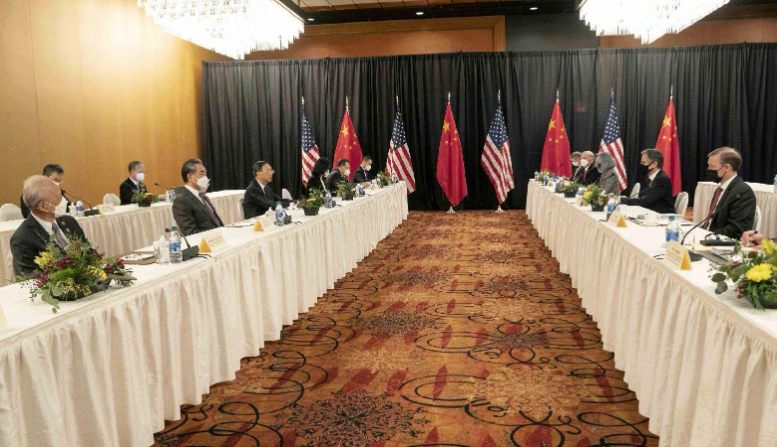
On March 18 and 19, China and the United States held high-level talks in Anchorage, Alaska — the first of their kind since Joe Biden took office as U.S. president. Hard-line posturing on an array of issues by the U.S. side and the cut-and-thrust at the start of the talks cast a shadow on the much anticipated meeting. Nevertheless, we should view the talks in a prudent and practical manner, while examining the two countries’ intricate bilateral ties.
Amid persistent downward pressure on China-U.S. relations, the Anchorage meeting is significant in the following aspects:
First, it is an important step following up on the consensus President Xi Jinping and President Biden reached in their recent phone call. The meeting is essential to breaking the ice and ushering in a new era of engagement. Four years under Donald Trump has taken its toll on China-U.S. relations and poisoned the atmosphere for dialogue, a problem that is only compounded by the coronavirus pandemic. All the 100-strong dialogue mechanisms between China and the U.S. had been brought to a halt.
Against such background, and guided by the phone conversation between the two presidents on Chinese New Year’s Eve, the Anchorage meeting has great importance in restarting dialogue. As State Councilor and Foreign Minister Wang Yi said, “Dialogue is better than confrontation.”
Second, the meeting was a showdown of the two countries’ respective governance agendas and strategic intentions, which helps each side sort out the concerns and policy red lines of the other and thus forestall sleepwalking into a new cold war. With China embarking on a new journey under its 14th Five Year Plan (2021-25), and the U.S. ushering in a new administration, the engagement offered an opportunity to explain policy priorities, respective concerns and red lines. It will help prevent miscalculation caused by inadequate communication. U.S. National Security Adviser Jake Sullivan’s remarks that the U.S. does not seek confrontation with China largely echoes China’s long-held principle of non-confrontation and non-conflict.
We should bear in mind that the Anchorage talks alone cannot reverse the downward trajectory of bilateral ties nor address the existing structural issues between the two countries. In the sharp exchanges that played out in front of the cameras, the difficulties and intricacies of bilateral ties were on full display. It is clear that the U.S. harbors strong intentions to intervene in matters related to China’s core interests, such as Taiwan, Hong Kong and Xinjiang, with the aim of slowing China's development and hindering its rise.
On the fronts of high-tech competition, reshaping global supply chains and U.S. geopolitical rebalancing in the Asia-Pacific region, the Biden administration is building a coalition against China. Meanwhile, the Biden administration has inherited some of the modus operandi of the Trump administration, while putting a premium on the strategic thinking of the Democratic Party. The goal is to form a long-term, sophisticated strategic framework to contain China in an orderly and steady manner.
More important, the tough and undiplomatic posturing of the U.S. side in Anchorage is a telltale sign that its foreign policy, strategic thinking aside, is a slave to domestic politics. The extreme policies of the Trump administration over the past four years have severely derailed the course of dialogue and shaken the foundation of bilateral relations. This is evident in the consistent negative perception of China among members of the U.S. public, as reflected by both the Pew and Gallup polls. The “China threat” has largely emerged as the prevailing view in the U.S. In its high-profile promotion of a “foreign policy for the middle class,” the Biden administration has played up the idea that the American way of life is under threat, which smacks of being a maneuver to rally public support.
Meanwhile, the changing balance of power is reshaping perceptions in each country toward the other, and consequently has a direct bearing on policy options. The changing dynamics of bilateral relations has shaken mindsets on both sides, including the rapidly shrinking GDP gap in 2020 — a process accelerated by the pandemic — and the much talked-about prospect of China overtaking the U.S. in aggregate economic output in 2021.
The Biden administration has got off to a good start on a couple of issues, including effective control of the pandemic, rolling out vaccines ahead of schedule and enactment of a $1.9 trillion economic stimulus plan, which will impact how the U.S. deals with China.
Secretary of State Antony Blinken said in his first foreign policy speech that the U.S. will cooperate with China where it can, compete where it should and confront where it must. This is the basic thinking behind the U.S. policy toward China and captures the nuanced understanding of the complexities of relations.
What transpired in Anchorage is a testament to the complexities of China-U.S. relations. Whether this meeting kick-starts a new pattern of engagement or only serves to fuel further tensions in bilateral relations remains to be seen. It depends on whether the two countries can stick to strategic thinking, look squarely at the complexities of bilateral relations and muster the resolve necessary to conduct practical cooperation that serves their mutual interests.
China must recognize the long-term nature of competition with the U.S. and remain committed to cooperation, with a clear-eyed recognition of American intentions and motives.
